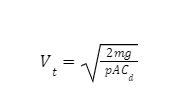As the thing descends, the gravity causes it to accelerate at first, as Isaac Newton anticipated. As the object moves rapidly, the atmospheric drag force grows until it is perfectly due to the total of gravity, at which point there is no overall force acting on an object. If all these two forces are fairly well balanced, the object would no longer accelerate or decelerate, but will continue to descend at a steady speed, known as the terminal velocity. Because air drag is greatly influenced by object size and shape, things having a high surface area (such as a parachute) will have a drastically lower terminal velocity then things with a smaller area. The object’s weight has an impact on the object’s air drag force and, as a result, its final velocity.
If the particle speed is constant, it is travelling at terminal velocity in fluid dynamics. The restricting force produced on an object by the fluid by which that particular object is travelling is the explanation for its constant speed. The fluid characteristics, projected cross-sectional contact area, and mass of an object can all influence the object’s terminal velocity. Let’s have a look at the Terminal Velocity’s Mathematical Representation and the Deduction of both the Terminal Velocity.
Terminal velocity
When an object descends through a fluid, it achieves terminal velocity, which is the maximum speed and velocity that it can achieve. This happens when the sum of the fluid’s drag force plus buoyancy matches the item’s downward gravitational pull. The net force on an object is zero in these instances. As a result, the object seems to have no acceleration.
The drag force of an object increases as its speed increases, although it is dependent on the substance it is travelling through (for illustration air or water). It’s possible that the item’s drag or resistance will finally match its gravitational effect (buoyancy is below). The object stops moving at this point and continues to fall at a constant speed known also as terminal velocity. When an object moves quicker than just its terminal velocity, it bogs down until it reaches it.
It is not, however, the most significant component. This answers why a flat bit of paper falls slower than the same piece of paper crushed into a ball. The paper is the same weight, but still the airborne drag forces had significantly reduced due to changes in the surface area as well as drag coefficient. The crumpled paper has a larger terminal velocity than just the flat paper as a result of this. This also explains why, when jumping out of an aeroplane, a parachute can reduce your terminal velocity. Because the parachute has a big surface area plus drag coefficient, as well as a tiny mass, it is subjected to significantly greater air drag forces than what you would without one.
Derivation of terminal velocity
A net force of an object descending towards the Earth’s surface, defined in mathematical terms as down being positive, is
 where:
where:
-
Vtis the terminal velocity
-
Cd is the drag coefficient
-
ρ is the density of the fluid through which the object is falling
-
gis acceleration due to gravity
-
A is the cross-sectional area projected by the object
-
m is the mass of the object that is falling
The net force is zero at equilibrium (Fnet = 0)[9], and the velocity will become the terminal velocity limt→∞ v(t) = Vt:
Solving for Vt yields
Conclusion
When a moving object’s speed is no longer growing or decreasing, it is said to have reached terminal velocity; the object’s acceleration (or decelerate) is also zero. Air resistance increases for a thing that is accelerating after being dropped from rest unless terminal velocity is attained because the force of air resistance is generally proportional to velocity of the falling object. The weight of both the falling objects equals the magnitude of air resistance at terminal velocity. Because the two forces are in different directions, the overall force on an object is zero, as well as the object’s speed is constant.
 Profile
Profile Settings
Settings Refer your friends
Refer your friends Sign out
Sign out















